While one looks at the infrastructure of a city in terms of intra-city connectivity, it is also as important to look at how well a city is connected to its neighbouring important cities through various modes of transport.
• Mumbai airport is the busiest airport in the country and has flights to a maximum number of destinations in the country. It is quite well connected to international destinations too.
• On the highways front, only the eastern side of the city can have surface connectivity and that is well taken care of by:
o NH-4 (Pune, Bangalore, Chennai)
o NH-8 (Ahmedabad, Jaipur, Delhi)
o NH-3 (Nashik, Indore, Gwalior, Agra)
o NH-17 (Goa, Kozhikode)
But with the burgeoning population and increasing economic activity in the city, constant upgradation of the existing infrastructure is needed. Some of the key projects are finally seeing some action, and should help enhance the city’s connectivity to the world.
In FY19, the currently operational Mumbai international airport reported passengers of 48.8mn – 20% higher than its peak capacity of 40mn. Along with inadequate capacity, its design (cross runways) and the land available at the site necessitated the development of a greenfield airport at a different location in the city. Globally, there are lots of precedents with cities like London, Madrid, and New York having multiple airports.
Like most projects in the city, this project too had its fair share of delays. Originally conceived in 1997, the project was delayed multiple times, over land acquisition and environmental clearance. But despite receiving the government’s nod and MoEF clearance in November 2010, the governing body CIDCO was able to invite tenders only in 2014. But since the GVK-led consortium (operating the existing Mumbai airport) was the only bidder in final rounds, the bidding was extended twice. Eventually, in February 2017, the GVK-led consortium won the project by outbidding the GMR-led consortium, by offering 12.6% revenue share (vs. 10.4% offered by GMR). Ground work started on the project in October 2017, and the ground breaking ceremony for the airport was performed in February 2018 by the Prime Minister Narendra Modi. The EPC contract for the airport is expected to be awarded in late 2019.
NMIA is expected to be one of the world’s largest “greenfield” international airports, offering world-class facilities for passengers, cargo, aircraft, and airlines. Navi Mumbai was selected as the location because of availability of large contiguous non-encroached land, superior social and physical infrastructure, and the fact that Navi Mumbai is expected to cater to the future growth in population, business, and commercial activities of MMR. The airport site is located in an area of 1,160 hectares — which can accommodate two parallel runways for simultaneous and independent operations with full-length taxi ways on either side of the runways. The airfield has been designed to accommodate new large aircrafts compatible with International Civil Aviation Organisation (ICAO) Aerodrome Code 4F.
Project details:
• Project Cost: Rs 160bn
• Airport Area: 1,160 Ha (2,867 acres)
• Runways: Two (Spacing 1550 m for independent operations)
• Terminal Building: 5,23,000 sq. mt.
• Capacity: 10mn passengers per year (60mn by 2030)
• Cargo Complex: 2, 01,581 sq. mt.
• Catering: 25,000 sq. mt.
• Fuel Farm (Ultimate Phase): 151,000 sq. mt.
• Baggage Claim Area – 13,290 sq. mt.
• General Aviation Apron area: 32,000 sq. mt.
• Automobile Parking : 5500 + 3500
Accessibility
• National Highways – NH4 and NH4B,
• State Highways – SH54, Sion-Panvel Highway, Aamra Marg
• Suburban Rail, Water Transport, Metro & BRTS
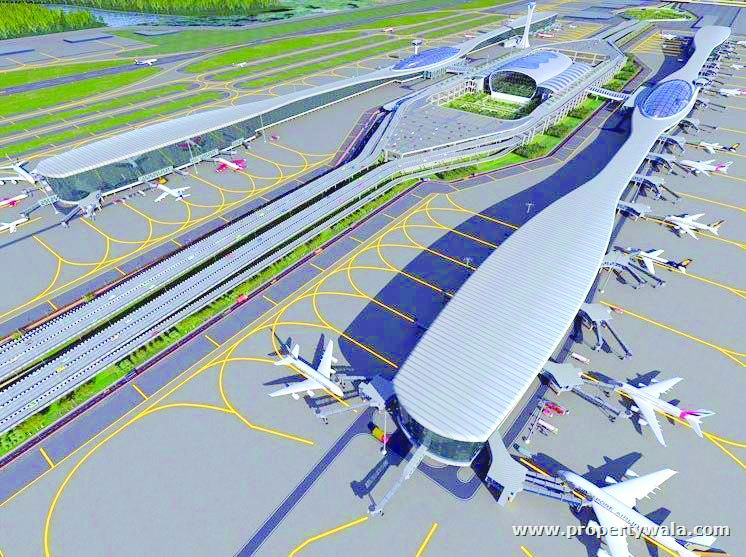
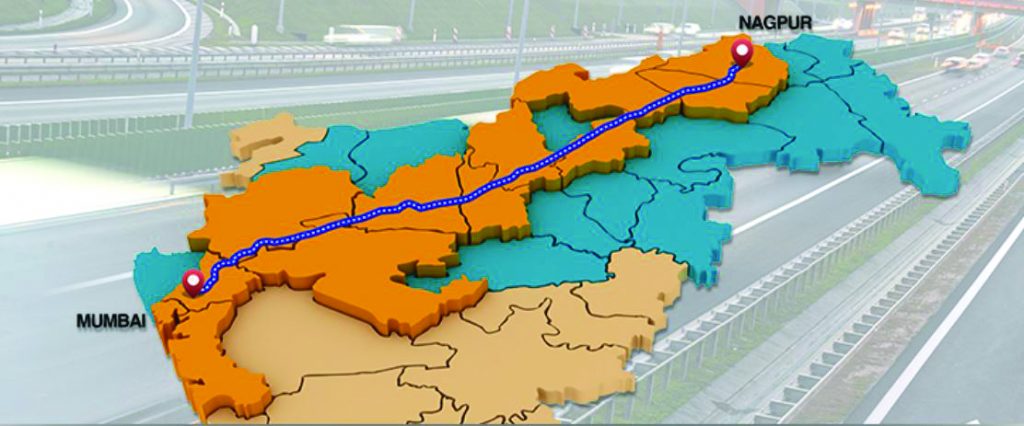
Overcoming various hurdles of farmer agitations, funding issues, land acquisition problem and NGO protests, the state government finally awarded the construction contracts of the Samruddhi Mahamarg in May 2018. The project is a reflection of the resolve of the state government in carrying out mega-scale infrastructure projects in the state. The project is expected to provide a big boost to the 10 districts that it will run through, while reducing the travel time between the two most important cities in the state.
The 700km long 8-lane expressway will directly connect 10 districts, 26 talukas and about 392 villages. It will have a speed limit of 150kmph, which will bring Nagpur and Mumbai within 8 hours reach. It will connect several industrial areas – the Delhi-Mumbai Industrial Mahamarg (DMIC), the Western Dedicated Freight Mahamarg (WDFC), dry ports of Wardha and Jalna, and Mumbai’s JNPT.
The expressway, with a total width of 120m and a central median of 22.5m, will follow international standards of design. It will have service roads on both sides that will connect through underpasses. It will have around 50+ flyovers, 24+ interchanges, more than 5 tunnels, 400+ vehicular and 300+ pedestrian underpasses provided at strategic locations. Extensive landscaping, tunnel lighting, bridge beautification, improved street lighting and digital signage will be used throughout the length of the expressway. It will also have CCTV surveillance and free telephone booths at every 5km to allow reporting in case of any accidents and emergencies.
The total cost of the project is Rs 550bn of which Rs 260bn is required for construction and the remaining for land acquisition and other use. The total required land is 8,311 ha – 100% of the same has been acquired (link here). In January 2019, the project received a big boost when a consortium of public sector banks, led by SBI, agreed to provide Rs 220bn out of Rs 260bn required for construction. While SBI agreed to fund Rs 85bn, other banks such as PNB, Bank of Baroda, Bank of Maharashtra, and LIC also agreed to contribute.
The project was divided into 16 packages and MSRDC has awarded all the packages – work has begun on all of them. The government is targeting to complete the project by 2022.
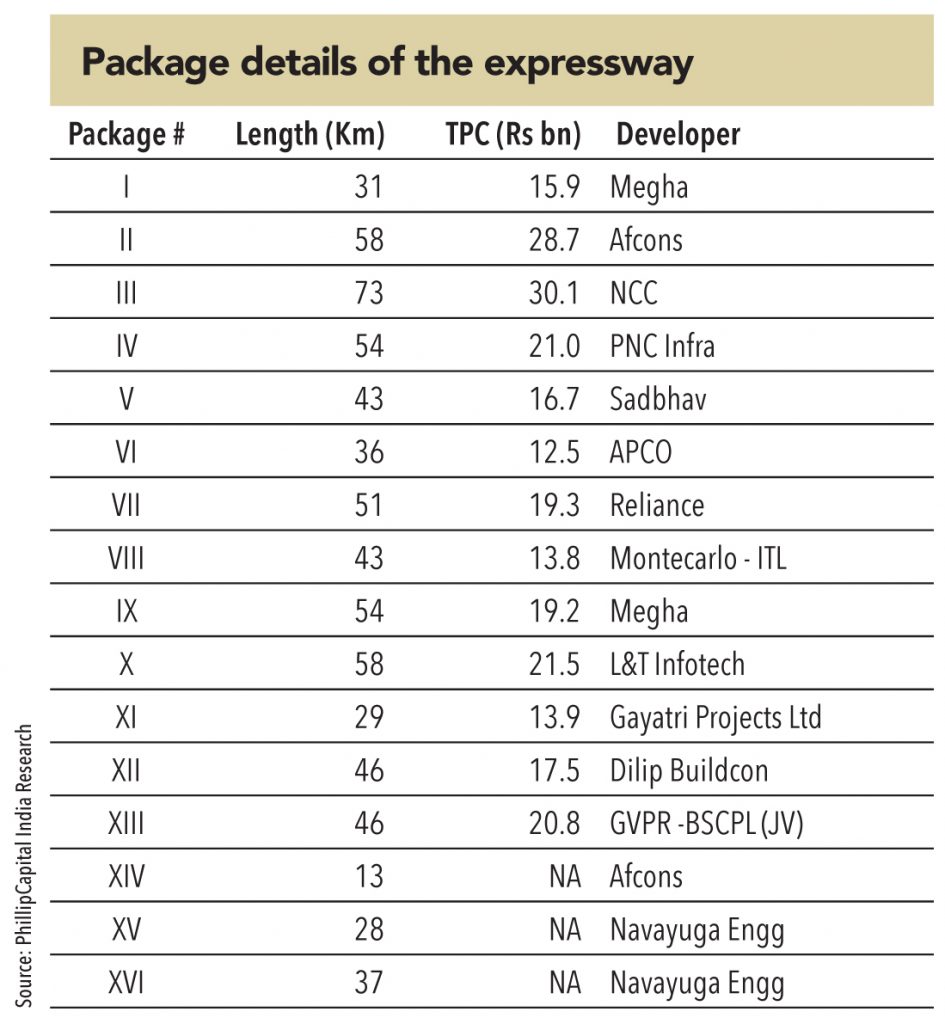
In November 2017, the minister for Road Transport and Highways, Mr. Nitin Gadkari, announced the Bharatmala Paryojna – the Rs 7trillion mother scheme of highway development over the next 10 years. The ministry took a good two years to prepare the detailed plan of this mammoth scheme, intended to decongest and expand the existing highway network of the country. As part of this scheme, the ministry plans to construct 42,000km of economic corridors – one part of them being the 1,250km Delhi-Mumbai Expressway.
The new expressway is planned along the Delhi-Gurugram-Mewat-Kota-Ratlam-Vadodara-Surat-Mumbai route. It will reduce the travel distance between the two cities to 1250km from the current 1450km, reducing travel time to 12 hours from the current 24 hours. This will be free of traffic stops and with a higher speed limit of 120kmph (vs. 80kmph currently). The expressway will pass through five states – Haryana (80km), Rajasthan (380km), Gujarat (120km), MP (900km), and Maharashtra (370km). The alignment, parallel to the NH-8, will lead to development in the new districts that it will run through.
The project is expected to cost Rs 1trillion. The currently under-construction Mumbai Vadodara Expressway has been subsumed in this project. The expressway has been divided into 40 packages, and companies like Ashoka Buildcon, Sadbhav Engineering, Apco Infra, Gawar Construction and Patel Infra have bagged few of the contracts that have been awarded. As per the latest update from the MoRTH, over 60% of projects under the expressway have been awarded by June-19. The project is targeted to be completed by March 2022.
The government is also mulling a 10km pilot electric highway on the proposed expressway on the lines of the A5 motorway in Frankfurt, Germany. The electric highway (stretch of 10km of autobahn), developed by Siemens, allows trucks, with the necessary equipment mounted on their roof, to use the electrified cables to travel at speeds of up to 90 Kmph without needing to use any diesel fuel, and converting back to diesel-powered internal combustion once they leave the electrified stretch.
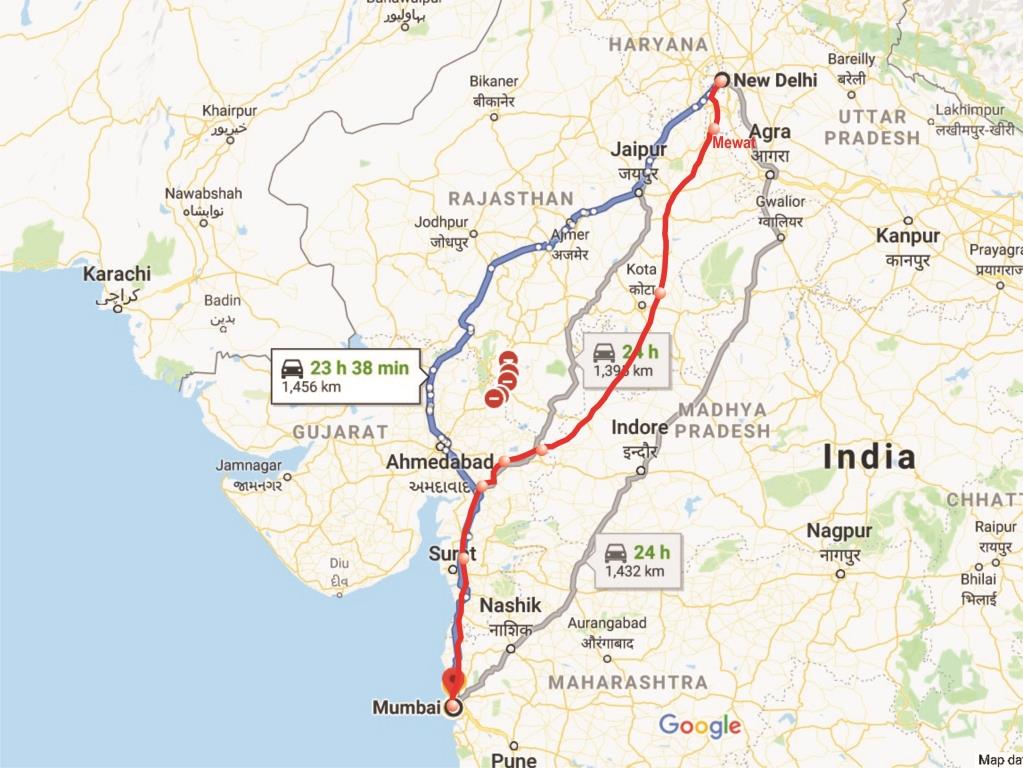
With the advent of social media and analytics, the world is embracing technology at a much faster pace, than it ever did before. Disruptive forces are at play in all fields – transport, retail, banking – you name it! Public transportation too, has taken a big leap forward, with the advent of app-based aggregators such as Uber, Lyft, Grab, and Ola. At the same time, the thrust on moving to electric vehicles, autonomous cars, and eventually, as envisioned by Elon Musk, solar-based self-driven electric cars promises to change future transport dynamics radically. In these times, though a little behind, the city of Mumbai is embracing technology in transport at a remarkable pace. Two key projects bear testimony to this – Bullet Train and Hyperloop.
This was the one of the dream projects of PM Narendra Modi – and he left no stone unturned to realize it. NHSRCL (National High Speed Rail Corporation Ltd) is implementing the 508km long Bullet Train project between Ahmedabad and Mumbai. Aimed at taking the country to the next generation and enhancing the overall travel experience, the Bullet Train, travelling at 320km/h (the current max speed is 150km/h by Shatabdi Express) will reduce the travel time between the two cities to little over 2 hours from the current over 6 hours.
The bullet train will be built on Japan’s E5 Shinkansen technology, which is famous around the world for holding a zero-fatality record. The route of Bullet Train will start from BKC in Mumbai and will end near Sabarmati Railway Station in Ahmedabad, with 12 Stations i.e. Mumbai, Thane, Virar, Boisar, Vapi, Bilimora, Surat, Bharuch, Vadodara, Anand/Nadia, Ahmedabad and Sabarmati. Most of the corridor will be elevated, except for a 21 km underground tunnel, of which 7 km will be undersea (under the Thane creek). The corridor will begin at an underground station in BKC and then traverse 21 km underground before emerging above ground at Thane.
The project is expected to cost Rs 1.08trillion and will be funded by JICA to the tune of Rs 880bn (@ 0.1% interest rate with repayment period of 50 years with a 15-year moratorium). Ground breaking ceremony was done by Indian and Japanese PMs on 14th September 2017 at Sabarmati in Gujarat. The project is targeted to be completed by 2023. Pre-construction activity has already started on the project and tenders have been invited for:
1) Civil works for 237km (expected size of Rs 200bn) in March 2019
2) 21km tunnel between Mumbai-Thane using TBMs and NATM
The Mumbai-Ahmedabad Bullet train project is a part of the HSRCL (High Speed Rail Corp of India Ltd) mega plan of multiple routes:
1) “Diamond quadrilateral” comprising of Delhi-Mumbai, Mumbai-Chennai, and Delhi-Kolkata
2) Delhi – Chandigarh – Amritsar
3) Delhi Chennai
4) Chennai – Bangalore – Mysore
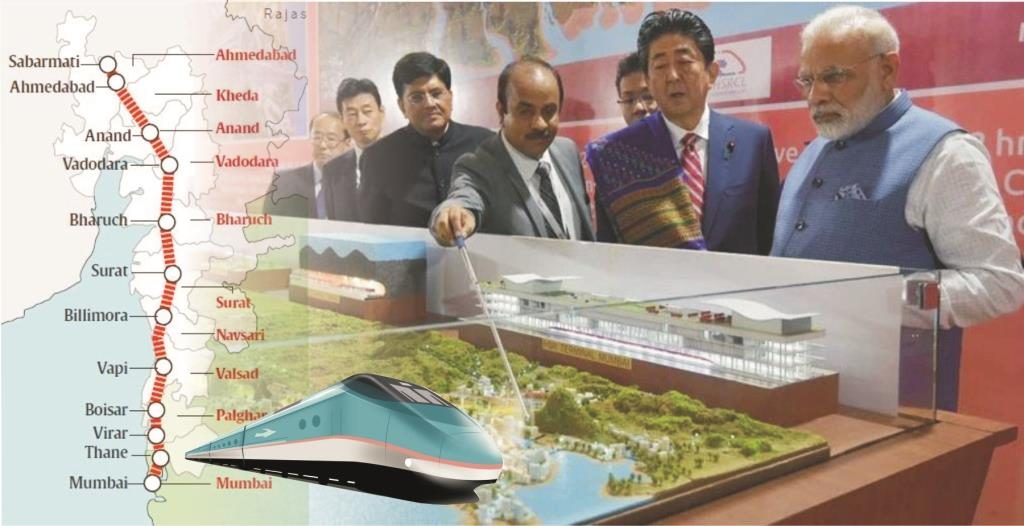
In November 2017, Mr Harj Dhaliwal, Virgin Hyperloop One’s MD for Middle East and India, signed an MOU with the Maharashtra state government, to conduct preliminary study on the feasibility of a Hyperloop track between Mumbai and Pune. It marked a significant event in city’s history – when it took the leap to being a leader from a laggard in terms of adopting new transport technologies (as has been the case with BRTS, MRTS and others).
Hyperloop is the latest mode of transportation, designed on Elon Musk’s concept of using low pressure to accelerate vehicles. Using this concept, passengers or cargo can be loaded into a hyperloop vehicle and accelerated gradually via electric propulsion through a low-pressure tube. The vehicle floats above the track using magnetic levitation and glides at airline speeds for long distances due to ultra-low aerodynamic drag.
A Hyperloop system is to be built on columns or tunnelled below ground to avoid dangerous grade crossings and wildlife. Advocates of the transport technology claim that it is fully autonomous and enclosed, eliminates pilot error and weather hazards, besides ensuring safety and cleanliness with no direct carbon emissions. Currently, multiple hyperloop projects are under various stages of development – between San Francisco and Los Angeles in the US and Abu Dhabi and Dubai in the Middle East.
Theoretically, travelling at a speed of over 600kmph, Hyperloop can reduce the travel taken for the 140 km journey (Mumbai to Pune) to just 25 minutes from the current 3.5 hours.
Virgin Hyperloop One is looking to start Phase 1 work on the Mumbai-Pune route by December 2019. Phase 1 involves building a 11.8km demonstration track with a private investment of US$ 500mn by 2023. After this, phase 2 will see the rest of the stretch being built with the track bifurcating into two in Mumbai — one headed to BKC and the other to Navi Mumbai – to facilitate cargo movement. The hyperloop corridor will be built either under the Mumbai-Pune Expressway or run parallel to it.

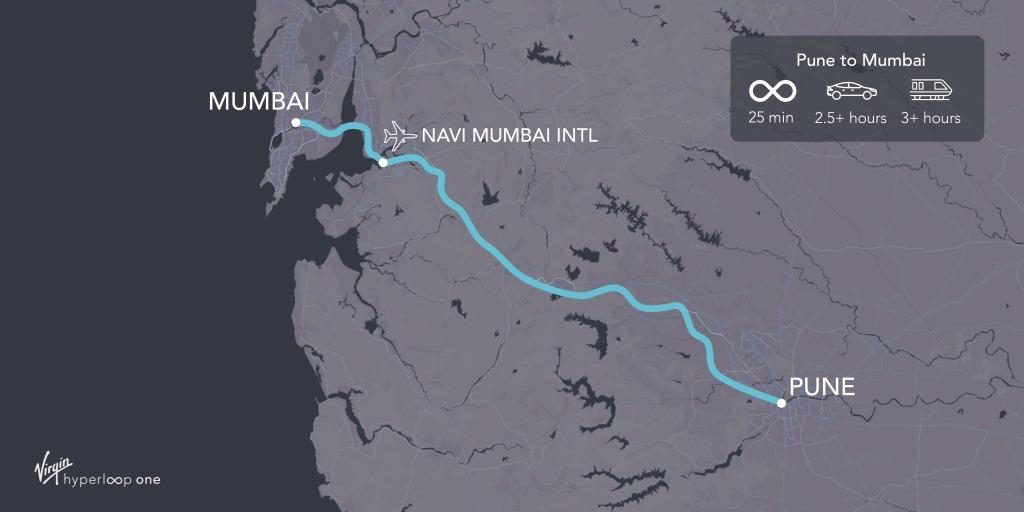
Mr. Enrique Penalosa, former mayor of Bogota, Colombia, once famously said – “A developed country is not where the poor have cars. It’s where the rich use public transport”. On that yardstick, Mumbai city in its current state would not even qualify as a third-world city. Decades of neglect by authorities and successive governments, lack of co-ordination between various authorities, and myopic planning have led to the crumbling state of infrastructure in the city. Multiple incidents of bridge collapses, ever increasing travel time, and over-crowding across modes of transport – in a true sense, the infrastructure of the city has completely collapsed.
However, there is definitely light at the end of this tunnel – and that light, has truly been lit in the last five years. An unprecedented quantum of projects awarded by authorities, that were stuck for decades, promise to transform the infrastructure landscape of this city like never before. Mammoth development in the metro network is expected to reduce travel time, on an average by 25%. Scores of flyovers and new roads will provide much-needed respite from bumper-to-bumper traffic on existing roads. New-age-technology modes of transport, like Bullet Train and Hyperloop, promise to make Mumbai a truly maximum city.
Subscribe to enjoy uninterrupted access